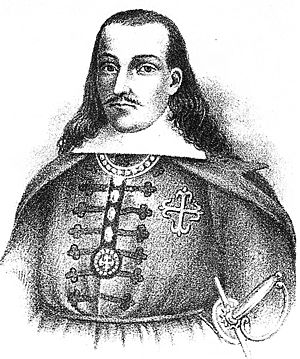Melchor de Navarra, Duke of Palata facts for kids
Quick facts for kids
Melchor de Navarra
Duke of Palata
|
|
|---|---|

19th century portrait by Evaristo San Cristóval
|
|
| 22nd Viceroy of Peru | |
| In office November 20, 1681 – August 15, 1689 |
|
| Monarch | Charles II |
| Preceded by | Melchor Liñán y Cisneros |
| Succeeded by | Melchor Portocarrero |
| Personal details | |
| Born | 1626 Aragon |
| Died | April 13, 1691 Portobelo |
Melchor de Navarra y Rocafull was an important Spanish politician. He was born in Aragon, Spain, in 1626 and passed away in Portobelo, Panama, in 1691. From 1681 to 1689, he served as the Viceroy of Peru, which was a large Spanish colony at the time. A viceroy was like a governor, ruling a colony in the name of the king.
Contents
Early Life and Career
Melchor de Navarra studied at the Universities of Oviedo and Salamanca in Spain. He was a knight of the Order of Alcántara, a special group of knights. He also worked as an advisor to the King of Spain, Charles II. He helped the king make important decisions for the country. In 1681, he was chosen to be the Viceroy and Captain General of Peru. At that time, Peru was a huge territory, stretching from Panamá all the way to Chile.
Leading Peru: Key Actions
Navarra y Rocafull left Spain in January 1681 and arrived in Lima, Peru, on November 20, 1681. He quickly started working to improve the government of the colony.
Protecting Indigenous People
One of his first actions was to issue a rule in 1684 to protect the Indigenous people. This rule aimed to stop unfair church taxes that were hurting them. He also counted the Indigenous population and made sure they stayed in their traditional homes.
Reopening the Mint
In 1683, he reopened the mint in Lima. A mint is a place where coins are made. This mint had been closed since 1572. Reopening it meant that Peru could make its own silver coins again.
Dealing with Pirates
During his time as viceroy, English pirates, like Edward Davis, started attacking the Pacific coast in 1684. These attacks lasted for four years. To protect the cities, Viceroy Navarra ordered the building of strong walls around Lima and Trujillo in 1686. A royal mapmaker named Juan Ramón Koening helped design the wall in Lima. In the same year, Spanish forces successfully fought off an attack by the pirate Davis.
The Great Earthquake of 1687
On October 20, 1687, a powerful earthquake hit Lima. It destroyed much of the city and killed 600 people in Lima and 700 in Callao. Before the earthquake, Lima had many straight streets, houses made of brick and adobe, and seventy churches. The earthquake ruined most of these buildings, including nearly all the churches and the city walls that were still being built.
Viceroy Navarra and his wife helped the victims a lot, even spending their own money. Lima was rebuilt after this disaster, but it was hit by another big earthquake in 1746. A famous painting of the "Brown Christ" on an adobe wall survived the earthquake, which many people saw as a miracle.
Building City Walls
After the earthquake, work on Lima's city wall started again. It was finished in 1687. The wall was very long, about 11,700 meters (about 7 miles). It was 4.5 meters (about 15 feet) high and had 34 defensive towers and five gates to enter the city. This strong wall protected Lima from invaders.
The city of Trujillo also got an oval-shaped wall, built between 1685 and 1687. Trujillo became the third walled city in America, after Cartagena de Indias and Callao.
A Strange Food Rule
Viceroy Navarra also made a strange rule about a local plant called Solanum muricatum. The Spanish called it pepino (cucumber), even though it wasn't a cucumber. People thought this plant could cause death if eaten with alcohol. The viceroy called it mataserrano, which means "highlander killer."
End of His Time as Viceroy
Viceroy Navarra's time in office ended when his replacement, Melchor Portocarrero, arrived in Lima on August 15, 1689. Navarra sent a detailed report about his work to Spain. He stayed in Lima for a while longer, waiting for a review of his administration. Later, he and his wife, Francisca Toralto de Aragón, began a journey back to Spain. Sadly, both of them died during the trip in 1691 and are buried in Portobelo.
See also
 In Spanish: Melchor de Navarra y Rocafull para niños
In Spanish: Melchor de Navarra y Rocafull para niños

